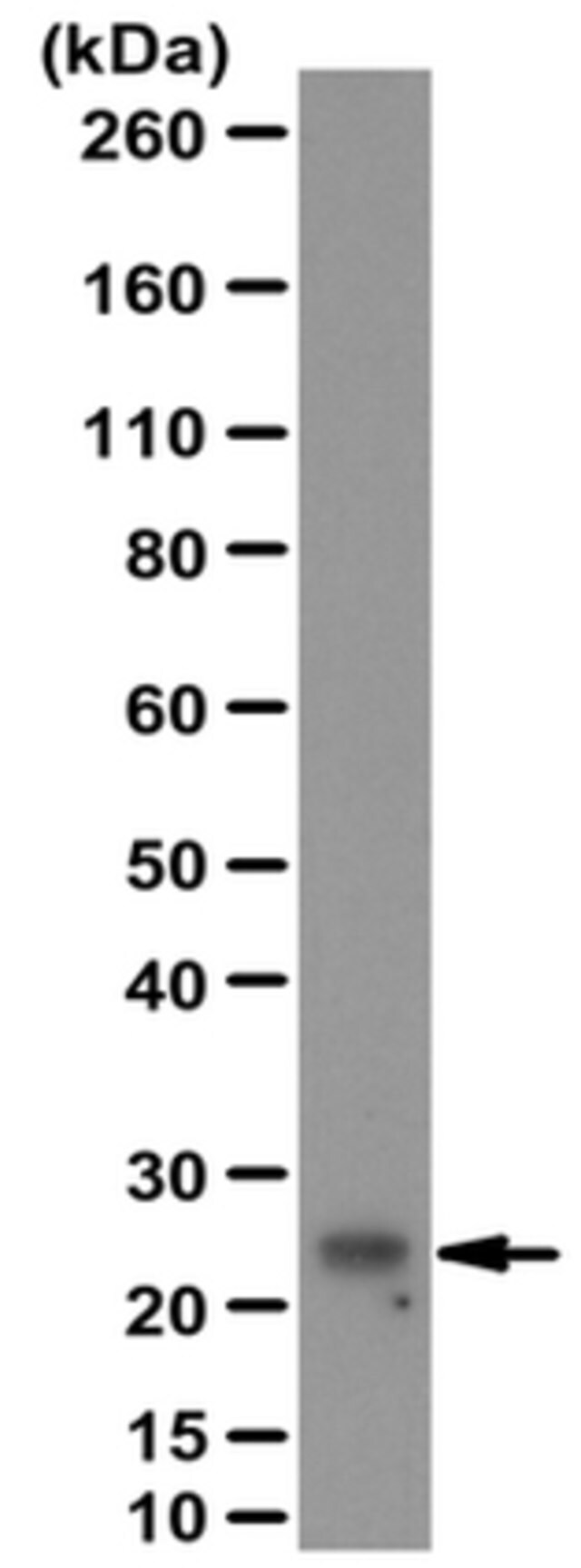您的位置:首页 > 产品中心 > Anti-GSTA4 Antibody
产品别名
Anti-GSTA4 Antibody
Glutathione S-transferase alpha-4, Glutathione S-transferase A4, Glutathione S-transferase Yk, GSTA4, GST 8-8, GST A4-4, GST K, GST Yk
基本信息
| eCl@ss | 32160702 |
| NACRES | NA.41 |
| General description【一般描述】 | Glutathione S-transferase alpha-4 (EC:2.5.1.18; UniProt P14942; also known as Glutathione S-transferase A4, Glutathione S-transferase Yk, GST 8-8, GST A4-4, GST K, GST Yk) is encoded by the Gsta4 gene (Gene ID 300850) in rat. Glutathione S-transferases constitute a family of isozymes that are involved in detoxification by catalyzing the conjugation of the reduced form of glutathione (GSH) to xenobiotic substrates. The GST family can be subdivided into the cytosolic, mitochondrial, and microsomal (a.k.a. MAPEG) proteins. Mammalian GSTs exist either as homodimers or heterodimers. The individual monomers were historically characterized by their quaternary structure and size, Yf (24.5 kDa), Yk (25 kDa), Ya1 (25.5 kDa), Ya2 (25.5 kDa), Yn (26.5 kDa), Yb1 (27 kDa), Yb2 (27 kDa) and Yc (28.5 kDa). The Y designation refers to the Y fraction (as opposed to the X and Z fractions) that were found during purification by Sephadex G75 chromatography. Two GST superfamilies exist that comprise either cytosolic or membrane-bound proteins. Evidence suggests that cytosolic GST increases bodily resistance to carcinogens, products of oxidative stress, environmental pollutants and certain anti-cancer drugs. The cytosolic GSTs are further subdivided into eight classes, namely alpha (GSTA), mu (GSTM), pi (GSTP), sigma (GSTS), theta (GSTT), kappa (GSTK), zeta (GSTZ), and omega (GSTO). GSTA4 exists as a homodimer composed of two Yk subunits. |
| Specificity【特异性】 | This antiserum selectively reacts with Yk from purified rat liver GST K and rat kidney GST J. No reactivity toward Ya, Yc, Yb1, Yb2, Yb3, Yf, or Yn subunits from other forms of purified rat GSTs (Hayes, J.D,, and Mantle, T.J. (1986). Biochem. J. 233(3):779-788). |
| Immunogen【免疫原】 | Purified rat liver GST K (YkYk). |
| Application【应用】 | Research Sub Category Oxidative Stress Research Category Signaling Anti-GSTA4 Antibody is an antibody against GSTA4 for use in Western Blotting, Immunohistochemistry (Paraffin). Immunohistochemistry Analysis: A 1:250 dilution from a representative lot detected GSTA4 in rat kidney, rat liver, and mouse cerebral cortex tissue. Western Blotting Analysis: A representative lot detected upregulated Glutathione S-transferase alpha-4 in liver cytosolic preparations from mice on high-fat diet (F) when compared with liver samples from mice on regular diet (Meakin, P.J., et al. (2014). Mol. Cell. Biol. 34(17):3305-3320). Western Blotting Analysis: A representative lot detected upregulated Glutathione S-transferase alpha-4 levels in liver homogenates from mice fed on diets supplemented with the antioxidant butylated hydroxyanisol (BHA) (Chanas, S.A., et al. (2002). Biochem. J. 365:405-416). Western Blotting Analysis: A representative lot detected purified rat liver GST K (YkYk) and kidney GST J (YkYk), but not Ya, Yc, Yb1, Yb2, Yb3, Yf, or Yn subunits from other forms of purified rat GSTs (Hayes, J.D,, and Mantle, T.J. (1986). Biochem. J. 233(3):779-788). |
| Quality【质量】 | Evaluated by Western Blotting in rat kidney tissue lysate. Western Blotting Analysis: A 1:5,000 dilution of this antibody detected GSTA4 in 10 µg of rat kidney tissue lysate. |
| Physical form【外形】 | Unpurified Rabbit polyclonal antibody in serum with 0.05% sodium azide. |
| Other Notes【其他说明】 | Concentration: Please refer to lot specific datasheet. |
产品性质
| biological source【生物来源】 | rabbit |
| Quality Level【质量水平】 | 100 |
| antibody form【抗体形式】 | serum |
| antibody product type | primary antibodies |
| clone【克隆】 | polyclonal |
| species reactivity | mouse, rat |
| technique(s) | immunohistochemistry: suitable (paraffin) western blot: suitable |
| NCBI accession no.【NCBI登记号】 | NP_001100310 |
| UniProt accession no.【UniProt登记号】 | P14942 |
| shipped in【运输】 | dry ice |
产品说明
| Target description【目标描述】 | ~25 kDa observed. |
| Storage and Stability【储存及稳定性】 | Stable for 1 year at -20°C from date of receipt. Handling Recommendations: Upon receipt and prior to removing the cap, centrifuge the vial and gently mix the solution. Aliquot into microcentrifuge tubes and store at -20°C. Avoid repeated freeze/thaw cycles, which may damage IgG and affect product performance. |
| Disclaimer【免责声明】 | Unless otherwise stated in our catalog or other company documentation accompanying the product(s), our products are intended for research use only and are not to be used for any other purpose, which includes but is not limited to, unauthorized commercial uses, in vitro diagnostic uses, ex vivo or in vivo therapeutic uses or any type of consumption or application to humans or animals. |
安全信息
| Storage Class Code【储存分类代码】 | 12 - Non Combustible Liquids |
| WGK | WGK 1 |






